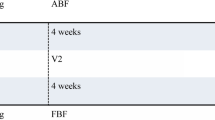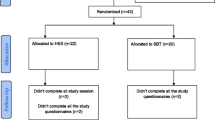Abstract
Although biofeedback has been used as a first-line therapy for fecal incontinence, it is known to be time consuming and demands attendance to a hospital during the whole period of treatment. In this study, we describe a new biofeedback device specifically developed for home treatment of fecal incontinence, which consists of a microprocessor controlled unit able to register and store the anal pressure waves corresponding to exercises performed by patients at home. In order to test the new device, a pilot study including ten patients with fecal incontinence was conducted. Evaluation of patients before and after the biofeedback training showed significant improvement in manometric and clinical parameters of anal continence. The new method may improve compliance of patients with the training program and reduce their need to be supervised during the treatment. It might represent a new alternative for the treatment of fecal incontinence.


Similar content being viewed by others
References
Engel, B. T., Nikoomanesh, P., & Schuster, M. M. (1974). Operant conditioning of rectosphincteric responses in the treatment of fecal incontinence. The New England Journal of Medicine, 290(12), 646–649.
Hay-Smith, E. J., Bo, K., Berghmans, L. C., Hendriks, H. J., de Bie, R. A., & van Waalwijk van Doorn, E. (2001). Pelvic floor muscle training for urinary incontinence in women. The Cochrane Database of Systematic Reviews, 1, CD001407.
Heymen, S., Jones, K. R., Ringel, Y., Scarlett, Y., & Whitehead, W. E. (2001). Biofeedback treatment of fecal incontinence: A critical review. Diseases of the Colon and Rectum, 44, 728–736.
Jorge JMN, & Wexner, S. D. (1993). Etiology and management of fecal incontinence. DIS Colon Rectum, 36, 77–97.
Jundt, K., Peschers, U. M., & Dimpfl, T. (2002). Long-term efficacy of pelvic floor re-education with EMG-controlled biofeedback. European Journal of Obstetrics, Gynecology, and Reproductive Biology, 105, 181–185.
Madoff, R. D., Parker, S. C., Varma, M. G., & Lowry, A. C. (2004). Faecal incontinence in adults. Lancet, 364, 621–632.
Margolin, D. A. (2008). New options for the treatment of fecal incontinence. The Ochsner Journal, 8, 18–24.
Musial, F., Hinninghofen, H., Frieling, T., & Enck, P. (2000). Therapy of fecal incontinence in elderly patients: Study of a home biofeedback training program. Zeitschrift fur Gerontologie und Geriatrie, 33, 447–453.
Nelson, R. L. (2004). Epidemiology of fecal incontinence. Gastroenterology, 126, S3–S7.
Norton, C., Chelvanayagam, S., Wilson-Barnett, J., Radfern, S., & Kamm, M. A. (2003). Randomized controlled trial of biofeedback for fecal incontinence. Gastroenterology, 125, 1320–1329.
Norton, C., & Kamm, M. A. (2001). Anal sphincter biofeedback and pelvic floor exercises for faecal incontinence in adults: A systematic review. Alimentary Pharmacology and Therapeutics, 15, 1147–1154.
Palsson, O. S., Heymen, S., & Whitehead, W. E. (2004). Biofeedback treatment for functional anorectal disorders: A comprehensive efficacy review. Applied Psychophysiology and Biofeedback, 29, 153–174.
Rockwood, T. H., Church, J. M., Fleshman, J. W., Kane, R. L., Mavrantonis, C., Thorson, A. G., et al. (2000). Fecal incontinence quality of life scale: Quality of life instrument for patients with fecal incontinence. Diseases of the Colon and Rectum, 43, 9–17.
Safioleas, M., Andromanakos, N., & Lygidakis, N. (2008). Anorectal incontinence: Therapeutic strategy of a complex surgical problem. Hepato-Gastroenterology, 55, 1320–1326.
Tjandra, J. J., Dykes, S. L., Kumar, R. R., Ellis, C. N., Gregorcyk, S. G., Hyman, N. H., & Buie, W. D. (2007). Practice parameters for the treatment of fecal incontinence. Diseases of the Colon and Rectum, 50, 1497–1507.
Yusuf, S. A., Jorge, J. M., Habr-Gama, A., Kiss, D. R., & Gama Rodrigues, J. (2004). Evaluation of quality of life in anal incontinence: Validation of the questionnaire FIQL (fecal incontinence quality of life). Arquivos de Gastroenterologia, 41, 202–208.
Funding
This work was financed by FIPE, the HCPA research fund.
Author information
Authors and Affiliations
Corresponding author
Ethics declarations
Conflict of interest
DC Damin, D Schirmer, PS Sanches, DP Silva Junior, AF Müller, and PR Thome are listed as inventors and hold a patent for the patient-controlled biofeedback device.
Rights and permissions
About this article
Cite this article
Damin, D.C., Hommerding, F., Schirmer, D. et al. Patient-Controlled Biofeedback Device for the Treatment of Fecal Incontinence: A Pilot Study. Appl Psychophysiol Biofeedback 42, 133–137 (2017). https://doi.org/10.1007/s10484-017-9352-6
Published:
Issue Date:
DOI: https://doi.org/10.1007/s10484-017-9352-6




